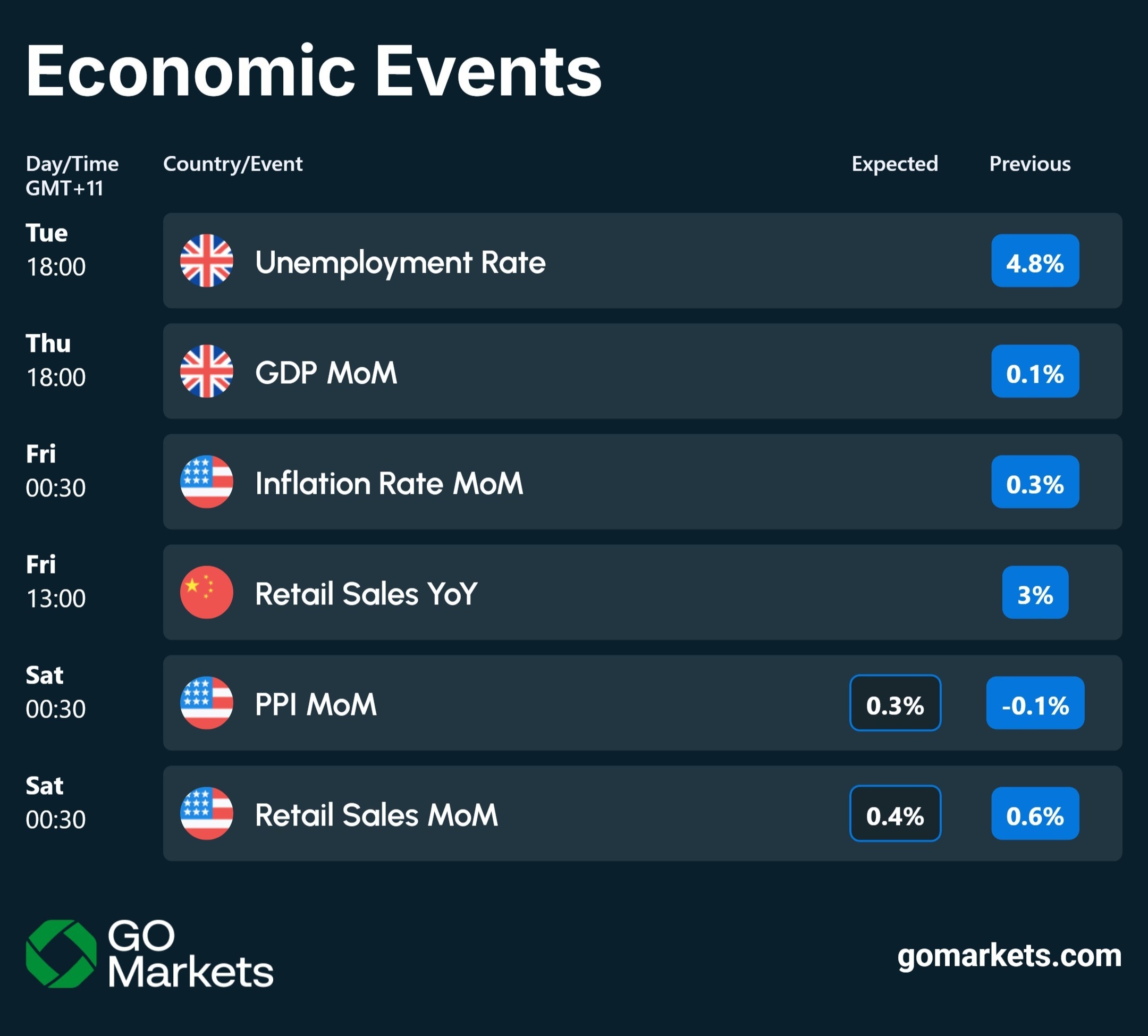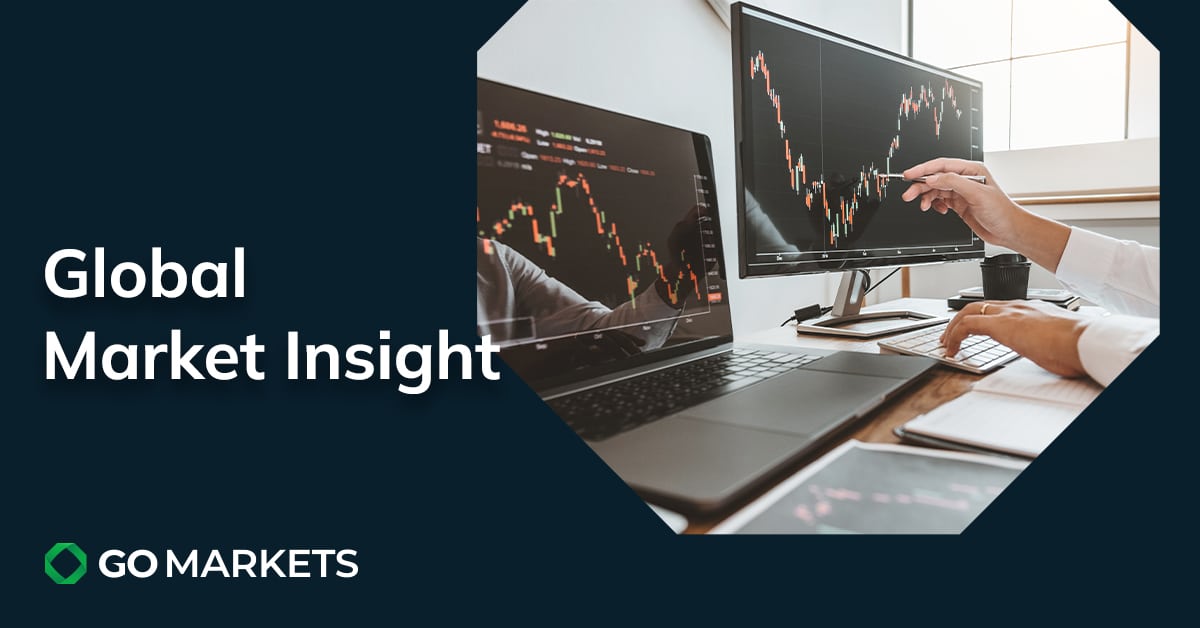市場新聞與洞察
透過專家洞察、新聞與技術分析,助你領先市場,制定交易決策。

Markets retreated last week, pulling back about 2.5-3% from record levels. While the decline is modest, it is marked by several headwinds that could create further pressure this week.
Government Shutdown Reaches Historic Length
The ongoing shutdown has now reached record duration, and there's still no clear resolution in sight. Healthcare remains the primary sticking point between the two sides. Some reports suggest potential progress, but the jury's still out on whether any deal will materialise or gain bipartisan support before the Thanksgiving holiday season.
Key Economic Data May Be Delayed
The shutdown's impact extends to data releases. Market-influencing government reports, including jobs numbers and CPI data, may be delayed this week — CPI is still technically scheduled, but the shutdown could affect its release. This data delay will make it harder to gauge the economy's true direction and could inject further volatility into markets.
Earnings Season Continues to Impress
Despite these macro headwinds, corporate America is delivering exceptional results. We're seeing an 82% EPS beat rate and 77% of companies exceeding revenue expectations. While we're in the final 10% of S&P 500 reports, some important retail stocks are still due. These consumer-facing companies could provide valuable insights into spending patterns and economic health.
NVIDIA Tests Critical Support Level
AI stocks are facing pressure, with NVIDIA testing a key technical level around $180-$185. The stock experienced five consecutive days of losses before bouncing strongly on Friday with a major wick rejection. If support at $180 breaks, we could see a drop to $165. However, Friday's bounce suggests a possible retest of $193. This is a crucial moment for the AI sector leader, and its direction could influence broader tech sentiment.
Market Insights
Watch the latest video from Mike Smith for the week ahead in markets.
Key economic events
Keep up to date with the upcoming economic events for the week.



Bitcoin and other cryptocurrencies have seen their prices decline rapidly in recent times as inflation has wreaked havoc across the market. The capitulation has seen Bitcoin lose almost 75% of its value since November 2021. The aggressive selling has seen the price fall to its lowest levels since November 2020.
The theory that Bitcoin would be a hedge against inflation seems have dissipated as the volatility the price has fallen as interest rates have increased. This shows how Bitcoin correlates more with riskier assets as opposed to steadier inflation hedges such as gold. The volatility surrounding BTC also picked up after brokers such as Binance and Celsius both halted swaps and transfers of cryptocurrencies.
This led not only to a drop in price but a significant drop in confidence as the market came to terms with the fact that the liquidity and ease of movement of the currency may not be as smooth as once thought. The Role of Institutional Investors The difference with the current Cryptocurrency Bear market and previous cycles is the role of institutional investors/traders. With Cryptocurrency ETF’s, coins tied to other currencies and funds now taking up large positions, the pure volume now in the market is significantly larger with larger position sizes.
According to one Cryptocurrency broker, just 51% of its bitcoin holders are in the green. This signals that there is a great volume of supply and as prices continue to drop and pressure builds, the potential for capitulation is very high as panic sets in. Institutions are also able to take much larger positions with higher leverage.
This means more aggressive moves down when their positions need to be liquidated. The Magical $20,000 level The support level that is screaming out to the market is the $20,000 level. It is the long-term support point going back almost 5 years and is a large psychological level.
The price was able to break through last week, however it rallied hard and is currently holding above. If the price can break through the magic $20,000 level, then it may trigger a range of stop losses and a surge of selling. The next support target should it break through would be approximately $14,000.
Looking further back, the most recent rise in price was unable to break through the 50 Day moving average before slipping lower. The 50 Day moving average is also becoming steeper indicating significant selling. Until the 50 Day moving average begins to plateau, it may be difficult for a rally to be sustained.
Bitcoin’s price can also be viewed in a downward channel beginning at its most recent peak. A breakout of the channel in either direction may give some indication of a change in trend as seen in the chart below. Ethereum Ethereum has largely for the same reasons seen in Bitcoin as significant a drop as Bitcoin has.
Whilst Bitcoin has shown a long term double top pattern, Ethereum looks more like a head and shoulders pattern which shows an equally exhausted price. The price has broken through almost all longer term supports. It was able to bounce near the $830-$860 level.
However, this price may come under threat again if sentiment weakens. Regardless of the direction, the next move it will likely require some consolidation before it either breaks through or bounces up. Looking further ahead, increased fears of a recession or an unexpected rise in interest rates may see further selling.
Alternatively signs of slowing inflation or lower than expected interest rate hikes may see a rally or a consolidation of the price. However, in the short term, the cryptocurrency sector remains very bearish.


The USA has seen a peculiar instance of widespread baby formula shortages. In many states around the country, more than half of the formula has been sold out in stores. Across the entire country, 40% of the formula is out of stock.
Causes Firstly, and quite tragically, there were recently two infants who died from a rare infection associated with one of the manufacturing plants of the formula. Investigators found traces of the pathogen Cronobacter Sakasakii in a Michigan production plant. In response, the FDA recalled several brands of formula, and the public was advised to avoid buying products tied to the plant.
This has added further pressure as some in the market packed and have been hoarding the safe baby formula. Secondly, the pandemic has caused large issues in the supply chain. Whilst many other products had to deal with supply chain crunches, for some reason the baby formula was hit particularly hard as consumers hoarded formula to extreme levels.
The high volatility meant that producers could not get a clear gauge of how much supply the market needed. There was also an increase in births across the country, and the need for supply jumped again. In summary, manufacturers were unable to accurately predict the supply that was needed due to the extreme changes in the demand.
Lastly, the USA’s trade arrangement and regulatory processes made it very difficult for overseas manufacturers to supply formulas to the USA. European products and suppliers tend to have a hard time passing FDA regulatory processes. The process is strict and can become quite drawn out.
Consequently, the international market has not yet been able to support the shortfall. Opportunities The shortage has provided some opportunities for companies within Australia. Specifically, Bubs Australia and A2M Milk have been able to benefit from the shortage.
Both companies saw their share prices jump as the market reacted to the news. Furthermore, BUB was given fast-track approval from the FDA to supply its formula to consumers in the USA. With the shortage set to continue in the short-term future, A2M and Bubs may continue to some positive momentum in the short-term future. he immediate share price of BUBS opened higher on the news before selling off as long terms investors 'sold the news' and A2M saw a strong jump in share price.
Both share prices have now settled as the market determines what to do next.


Some of Australia’s largest gold miners have slumped to their 52-week price lows as rising costs and labour shortages have pushed their share prices down. St Barbara, (SBM), Ramelius Resources, (RMS) and now Evolution Mining, (EVN) have all reported disappointing updates to the market. The collective weakness has reverberated across the sector with gold mining giants Newcrest Mining (NCM) and Northern Star (NST) also seeing strong sell offs as well.
Inflation Problem High volatility and inflation usually increases the market’s interest into Gold, as investors and the like look towards some stability and assurance. However, inflation has caused widespread problems for much of the economy and the mining sector has been hit quite hard. With rising operations costs, labour and supply chain issues, profitability and future forecasts have seen a decrease.
Covid has and continues to cause distress and disruption as staff absenteeism is on the rise and extreme weather has limited the ability for these companies to operate, especially within Australia. The Price of Gold The price of gold has seen a strong push in the last two years. However, it has been unable to break through the $2080 USD per ounce resistance level.
It has come down since the height of the Russian/Ukraine conflict and the initial inflation panic. It is now ranging around with quite choppy price action. On a longer time, frame, it can be observed that the chart is still holding the long-term support zone.
Until the price breaks through either of the zones a significant move in either direction will be unlikely to occur. Evolution Mining, (EVN) Evolution Mining (EVN) specifically not only cut its forecast for the 2022 FY but also its 2023 and 2024 forward guidance causing significant damage to its share price. As can be seen below, the price had already been trending down from its peak of $6.59 in July 2020.
The price is currently sitting on a relatively strong long term support zone between $2.00-2.60. Selling may continue through this zone, however, it will require significant volume to break through. EVN’s share price also dragged down other gold miners and large cap gold mining company Northern Star, (NST).
The companies’ price action is almost identical. This means when one of their share prices is declining it is likely the other will follow. Similarly, to Evolution Mining is approaching a support zone between $5.90 – $7.00.
Looking ahead The future for the share price of these companies is obviously at the whim of what the gold price decides to do and their own ability to get gold out of the ground. As discussed above, EVN specifically has outlined that it the short to medium term it will struggle to produce significant amounts of gold. The price of gold is still an unknown, however Geopolitical volatility or Covid events may see a shift in the price.


What is an ETF Most people have heard of ETFs but not everyone knows what they are. An ETF is an Exchange Traded Fund and they are extremely popular amongst retail investors and novice investors. Companies such as Beta shares, Vanguard, Blackrock and others create and manage these holdings on behalf of investors.
An ETF is a collections of stocks that is grouped together to generally replicate the structure and weighting of an index such as the ASX200 or the Nasdaq. Alternatively, an ETF can also be a collections of assets that represents a sector or industry such as an Energy ETF. The market for ETFs has grown substantially with new ETFs being created regularly.
The value for ETFs in the USA by the end of November 2021 was worth 3 Trillion dollars. The advantages of investing in ETFs is that they are generally well diversified and that they don’t require constant administration or management. In addition, they are seen as being relatively passive as holders of shares of the ETF do not need to manage the buying and selling of the holdings of the ETF.
Many ETFs offer dividend reinvestment plans included many investors will not look at their holdings for a long time. The truth of ‘Passive’ Investing Are ETFs really passive? The reality is ETFs require a great deal of management and administration.
The managers of the ETFs must constantly adjust their holdings accurately to reflect either the rules of the ETF or the weighting of the companies on the index. Therefore instead of the ETFs seemingly operating independently they are actually constantly changing all the time. Some ETFs will adjust by buying or selling shares at the end of the trading day.
As indices rebalance, usually every three month, six months or 12 months, the ETF must reflect those changes. The ‘Flow’ on effect The issue is when an Index rebalances, the ETF is required to buy or sell the stocks that are being removed or added. As ETFs have such large holdings in the individual companies their buying and selling can often have quite a strong effect on the price flow of the shares.
This problem is exacerbated with ETFs that hold small cap companies. These smaller companies are even more at risk of a run by an influx of money coming into an ETF’s buying/selling patterns. This can lead to undesirable outcomes as the managers of the ETF must fight themselves to reach their required buy/sell volume of assets.
Potential Issues Blackrock is one of the companies that creates and hold ETFs in various sectors. One of its ETFs tracks 30 energy stocks. At one stage it held 8% of the shares of one of its holdings of one stock.
The cashflows from investors into the ETF were artificially driving up the price of the stock. Essentially, with so many shares to buy and sell, the ETF is ‘fighting itself ‘to fill its orders. This sees a very sharp increase/decrease in price usually with large volume.
In response to this unique problem the S&P Dow Jones Index in consultation with Blackrock created new rules for holdings to be added to the ETF and improve liquidity. For traders, ETFs create potential trading opportunities because as the old saying says “follow the money”. The ‘liquidity vacuum’ that ETFs create can often be quite aggressive moves to a stock’s price action substantially.


Adobe Inc. (ADBE) announced its latest earnings results after the closing bell on Thursday for its second quarter fiscal year 2022 ended June 3. The American software company reported revenue of $4.386 billion for the quarter (up 14% year-over-year), beating analyst forecast of $4.345 billion. Earnings per share also reported above analyst expectations at $3.35 per share vs. $3.31 per share estimate. ''Adobe achieved record Q2 revenue with strong demand across Creative Cloud, Document Cloud and Experience Cloud,'' Shantanu Narayen, chairman and CEO of Adobe said following the latest financial results. ''We are winning in our established businesses and seeing significant momentum in new categories from content authoring for a broad base of creators to PDF functionality on the web to the leading real-time customer data platform for global enterprises,'' Narayen concluded. ''We delivered another quarter of strong financial results, with greater than $2 billion in operating cash flows demonstrating the strength of Adobe’s growing revenue streams and financial discipline,'' said Dan Durn, executive vice president and CFO of Adobe. ''Our operating model continues to fuel consistent growth, enabling the company to invest in category-leading cloud solutions and emerging innovations that are gaining traction in the marketplace,'' Durn added.
Adobe Inc. (ADBE) chart Share price of Adobe was down by around 2% at the market open on Friday, trading at $357.37 per share. Here is how the stock has performed in the past year: 1 Month -10.80% 3 Month -21.47% Year-to-date -37.22% 1 Year -37.06% Adobe price targets UBS $415 Stifel $500 Baird $450 Deutsche Bank $500 Wells Fargo $425 Mizuho $480 Citigroup $380 Adobe is the 59 th largest company in the world with a market cap of $167.63 billion. You can trade Adobe Inc. (ADBE) and many other stocks from the NYSE, NASDAQ, HKEX and the ASX with GO Markets as a Share CFD.
Sources: Adobe Inc., TradingView, MarketWatch, Benzinga, CompaniesMarketCap


Accenture (ACN) reported its latest financial results before the market open in the US on Thursday. The Irish-American professional services company reported revenue of $16.159 billion for the third quarter of fiscal 2022 vs. $16.04 billion expected. Earnings per share missed analyst expectations for the quarter at $2.79 per share vs. $2.86 per share estimate. ''Our very strong financial results for the third quarter reflect continued broad-based demand across markets, services, and industries, and the continued recognition of the outstanding talent of our 710,000 people.
We continue to gain significant market share, and our services have never been more relevant as our clients turn to us as the trusted partner for the solutions they need to accelerate growth and become more resilient and efficient,'' Julie Sweet, CEO of the company said in a press release after the earnings announcement. Accenture (ACN) chart Shares of Accenture were down by around 1% during the trading day on Thursday at $282.45 per share. Here is how the stock has performed in the past year: 1 Month -3.00% 3 Month -13.07% Year-to-date -31.78% 1 Year -3.01% Accenture price targets Deutsche Bank $364 Cowen & Co. $330 Baird $340 Morgan Stanley $390 RBC Capital $435 Goldman Sachs $386 Barclays $455 Accenture is the 52 nd largest company in the world with a market cap of $179.21 billion.
You can trade Accenture (ACN) and many other stocks from the NYSE, NASDAQ, HKEX and the ASX with GO Markets as a Share CFD. Sources: Accenture, TradingView, MarketWatch, Benzinga, CompaniesMarketCap

